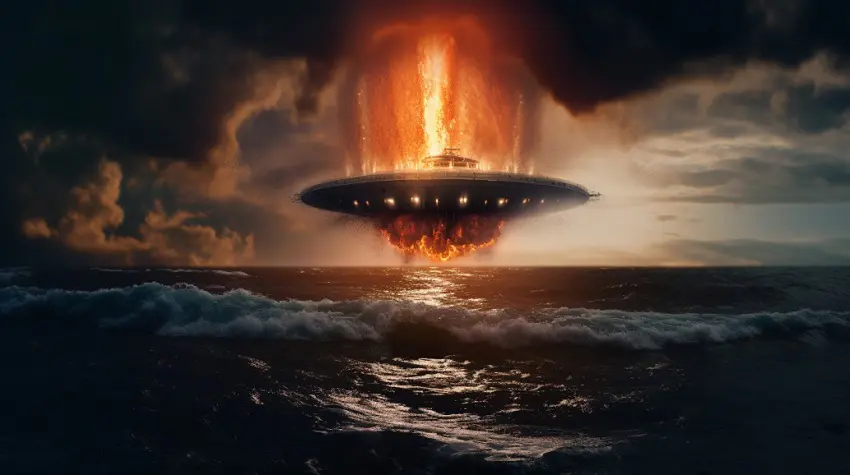
The Grand Quest Begins
As the sun began its descent on another October day in the year 2022, an extraordinary proposition was unfurling within the hallowed halls of Harvard University, the incubator of many intellectual odysseys. From the study of the esteemed Professor Avi Loeb, a theory as bold as it was beguiling emerged. It suggested the existence of a celestial peculiarity that could irrevocably shift our cosmic understandings.
A seemingly unassuming object named IM1, landing on Earth in 2014, had captured Professor Loeb’s astute attention. It was not the mere moniker, a clinical identifier for an interstellar visitor, that piqued the professor’s interest, but rather its perplexing properties. This interstellar traveler, darting through the void like a restless fireball, exhibited idiosyncrasies that nudged open the door to extraterrestrial prospects.
With a velocity that would put the fastest comets to shame, and a trajectory defying the Sun’s gravitational allure, IM1 was a puzzle on the wing. It weathered the cosmic elements with an uncanny resilience that suggested origins beyond our solar cradle.
No sooner had Professor Loeb unfurled his theory, did he find himself under the scrutiny of skeptical eyes. Doubters, ensconced in their comfortable orbits of understanding, tried to dismiss Loeb’s postulations as whimsical speculation. But far from being disheartened, the professor took these challenges as a rallying cry to embark on a daring journey of exploration and discovery.
With the spirit of intrepid explorers of the past kindling his resolve, Professor Loeb confronted the murmurs of disbelief and the icy winds of skepticism. The cosmic enigma became his uncharted sea, his scholarly rigor the sturdy ship, and his unwavering curiosity the compass steering him through the mist of uncertainty. The stage was set for an expedition into the astral wilderness.
As we unfurl this chronicle, dear reader, you are cordially invited to join Professor Loeb on this grand quest. The echoes of antiquity, the enigmas of the present, and the potential revelations of the future compose the symphony to which our narrative gyrates. Together, we shall voyage to the farthest reaches of human comprehension, lending our ears to the cosmic tales whispered by the mysterious IM1. Are you prepared to embark upon this celestial sojourn, in pursuit of answers to our grandest inquiries?
The Journey
To take the reins of such an ambitious venture, Professor Loeb assembled a harmonious symphony of erudite minds. Each virtuoso of this intellectual orchestra held mastery in their respective fields, all of them integral to the profound symphony of discovery that was about to resonate through the halls of knowledge.
The voyage they embarked upon was no ordinary journey. While their aim pointed towards the mighty Pacific, their challenges would not be physical tempests but tempests of data, torrents of enigmatic variables they must navigate. Their battles would not be against raging seas but against the surging seas of scientific uncertainty.
Their arsenal of exploration was both sophisticated and innovative. A magnetic sled was their trusty steed as they sifted meticulously through the ocean’s depths. In this cosmic haystack, they were on the hunt for the elusive needles, fragments of IM1, each one a microcosmic marvel hidden in the vast earthly sea.
The suspense crescendoed when the first spherule was unearthed, a microscopic orb bearing a universe of possibilities within its minuscule form. A hush fell over the team as Professor Loeb held the tiny potential key to the cosmos’ secrets, the beating of their hearts echoing the rhythmic lullaby of the nearby ocean.

No moment was squandered as the spherule, a grain-sized vessel of profound aspirations, was immediately forwarded for rigorous analysis. It was treated with the delicate yet determined curiosity of an archaeologist studying an artifact of an ancient civilization. Every test, every analysis, every scrutiny was a step closer to affirming or dismissing the bold hypothesis of Professor Loeb.
The journey they undertook, a blend of strenuous endeavors, unwavering optimism, and spine-tingling suspense, was a tribute to the tenacious spirit of human curiosity and the tireless quest for knowledge. From the intellectual bastion of Harvard to the mysterious depths of the Pacific, their odyssey was unlike any other. But the heart of their journey, the most potent revelation, was yet to lie before them. Indeed, their voyage was far from its end.
The Alien Spherules
In the vast chronicle of cosmic investigations, the spherules emerged as enigmas. These minute anomalies, small enough to nestle on a fingertip, held a universe of implications within their microscopic confines. Their geometry echoed cosmic design—a sphere, the simplest, most balanced form, offering a touch of the cosmos in the very palm of the hand. A metallic luster bathed each spherule, reflecting the twinkling of distant stars from which they might have originated.
The peculiarity of the spherules lay in their un-Earthly attributes. Their diminutive size and lightweight properties differentiated them from the substances familiar to us, confounding our terrestrial norms. In contrast, the commonplace spherules on our planet, born from volcanic eruptions or celestial collisions, seemed coarse and lackluster. The alien spherules appeared refined, gleaming with an ethereal glow that hinted at their cosmic origin.
To grasp the profundity of these spherules, one must journey into the realm of interstellar materials. These intergalactic nomads, traversing the fathomless reaches of the cosmos, endure formidable extremities of heat and radiation. Each carries a chronicle of its journey, offering glimpses into the uncharted celestial expanses. The discovery of such materials within our planetary bounds could reshape our cosmic comprehension, casting fresh light on our place within the celestial dance.
The unearthed spherules echoed Professor Loeb’s earlier speculations regarding IM1’s fate. This celestial traveler, speeding through our solar system, may have succumbed to intense solar radiation, causing its surface to vaporize and scatter these spherules in its wake. Their discovery was a testament to Loeb’s scientific acumen, an embodiment of his visionary insights.
The spherules intrigued the scientific world, their unusual features sparking a flurry of discussions. Might they indeed be fragments of an extraterrestrial vessel, as Professor Loeb proposed? Or were they the residue of an as-yet-unknown cosmic event? The unraveling of this mystery demanded an exhaustive study of these spherules—an expedition promising to delve deeper into the cosmic conundrum.
As the new phase of their quest unfolded, Professor Loeb and his team carried the weight of these minuscule spherules and their monumental implications. This exploration marked a double journey—into the microcosm of the alien fragments and the macrocosm of the cosmos—a journey heralding a revelation that could alter our understanding of the universe and our part within its infinite tableau.
A New Frontier
Embarking on the intricate deciphering of these celestial emissaries, our intrepid explorers ventured inward, to the heart of the enigmatic spherules. A beacon of scientific achievement in their arsenal, the X-ray Fluorescence analyzer, would be their guide. This tool, though formidable in name, served a solitary function: to unveil the hidden constituents of the spherules by exciting them with X-rays and studying the unique rays they subsequently emitted.
What they uncovered was akin to a cosmic mosaic: a fascinating assembly of iron, silicon, magnesium, and titanium. These elements, while familiar denizens of Earth, presented themselves in curious proportions—deviant from those found in standard solar system materials. Further intriguing was the divergence of these ratios from the control regions, a clear pointer towards an extraterrestrial origin, aligning with Professor Loeb’s initial hypothesis.
In the lattice of elemental abundance, the presence of uranium and lead demanded particular notice. Their appearance was not merely incidental but bore the key to the temporal aspect of the spherules. Uranium, a radioactive entity, gradually metamorphoses into lead, a process unfolding over eons. By inspecting this subtle transmutation—the uranium-to-lead ratio—scientists could employ the method of radiometric dating to infer the age of the sample.
The implications were staggering. The spherules could be relics from an epoch preceding the birth of our solar system. These cosmic voyagers may have journeyed through the interstellar void since the cosmos was a nascent sea of embryonic celestial bodies. The secrets preserved in their atomic fabric could bear testament to a period of the universe lost in the mists of time.
Unravelling these insights was like translating a coded language, an elemental script written across the expanse of the cosmos. Each spherule presented a chapter in this ancient narrative, attesting to the awe-inspiring scale of the universe. A speculative yet thrilling possibility emerged—the spherules could be the most ancient matter known to us, acting as cosmic chronicles shedding light on the formative years of the universe.
Upon interpreting the results, our explorers found themselves at the threshold of a novel domain of understanding. They were closer to deciphering the grand cosmic narrative, but each revelation posed new questions, similar to doorways leading to further labyrinthine corridors of knowledge. Such is the enduring spirit of scientific discovery: every answer illuminates the path to deeper enigmas. In these mysteries reside the allure of the cosmic quest, forever propelling the explorer into uncharted territories.
The Implications and Future Directions
This expedition, captained by the courageous Professor Loeb, shall unquestionably occupy an esteemed place in the annals of scientific exploration. Prompted by the bold proposition that IM1, that enigmatic celestial visitor, might be an interstellar courier, it unearthed the hypothesis that the collected spherules were like fossilized chapters of a cosmic tome, seemingly inscribed in the grand nursery of the universe itself.
The shockwaves of this quest resonated far and wide, stirring the halls of academia and igniting the imagination of even the casual observer. The discoveries did not simply broaden our cosmic understanding, but they posed fresh fuel for the eternal question – are we truly the sole inhabitants of this vast universe? Do we share the cosmic waltz with unseen partners, somewhere out in the ether of space? The spherules, these silent messengers, offered intriguing suggestions yet left the query tantalizingly unanswered.
With the wind of discovery at their backs, Professor Loeb and his team charted a new course for a further expedition in the spring of 2024. The Pacific Ocean, the scene of their initial triumph, called to them once more. The excitement of uncovering more celestial secrets was palpable, a siren song impossible to resist.
And thus, we find ourselves at the cusp of a new chapter in our exploration of these cosmic spherules. This account, while a significant step, merely scratches the surface of a narrative far grander in scope. It blends a sense of profound achievement with an insatiable curiosity, echoing the thrilling conclusions found within the pages of Verne’s, my, timeless tales. The end of this segment signifies not an ending but the advent of a new epoch of exploration into the uncharted expanses of cosmic knowledge. Let us gaze upon the future with ceaseless wonder, as the universe is a never-ending tale, forever being written by the indelible ink of time.
Having journeyed through the depths of the article, embark on a new expedition by propelling it into the vast sea of social media.
